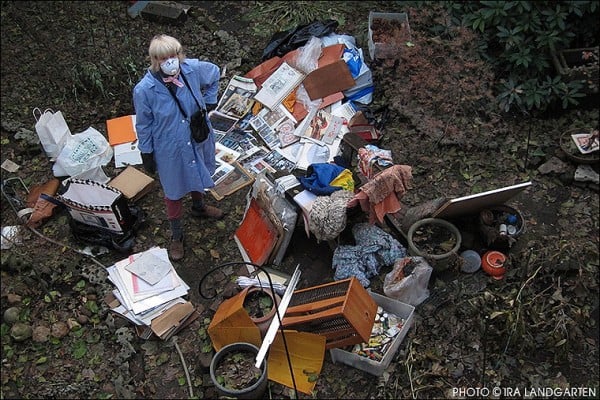Insects, sunlight, dust, mold, and mishandling can be harmful to books. But perhaps the greatest threat to these artifacts—other than fire and theft—is water damage. Our recent Horror Story contest put this fact front and center, as many submissions involved water damage.

Do not store valuables in basements and attics. These locations are more prone to water damage than your main living space. Large fluctuations in temperature and humidity can also damage books and photographs. Attics are susceptible to leaky roofs. Basement dangers include leaky water heaters, broken water pipes, and flooding.

Water Damaged Books
If you have valuable books (monetarily or sentimentally), you may wish to consult a trained conservator. The following suggestions are for drying books printed on “uncoated” paper. “Coated” paper—often used in picture books—usually has a thin clay coating that requires a different approach.
Damp Books
If your book is only damp, stand the book upside down (top down) and fan the pages. Support the book with bookends or unopened cans of food (remove labels so ink won’t stain your book). Turn the book over every few hours to dry its edges, and re-fan the pages at the same time.
When the book starts to feel dry to the touch, place the covers between towels or layers of paper towels. Place it under a sheet of plastic or a covered board with evenly-distributed weight on top. Use a brick or heavy canned goods as a weight. This reduces the risk of warping as the book dries. Use a fan to circulate the air, but don’t point the fan directly at the book. Check the book each day to monitor progress until the dampness dissipates completely.
Wet Books
Very wet books should have a chance to drain first. Place the top edge of the book upright on a cloth or layers of paper towels. Tilt the book on a sponge so the water drains through the edge of the book and not through all of the pages. Keep the book covers open, but do not fan the pages during this step.
Once the book has drained, interleave the pages with paper towels or blotting paper that extends about 1″ beyond the edge of the pages (except at the edge the book is standing on). Place these interleaving sheets every 10-20 pages. But don’t stress the binding with too much interleaving. Open the covers and stand the book up on a few paper towels or a cloth and let it rest while the absorbent interleaving material does its thing.
Remove these interleaving sheets once they become wet, and place the new sheets elsewhere in the book to speed the drying process. Repeat this process a few times, and turn the book over each time you change the interleaving material in order to let the edges dry. When the book feels dry to the touch, remove the interleaving sheets and reshape the binding to make it square. Follow the instructions above for damp books.
The drying procedures described above may take several days or longer, depending on the size and thickness of the book. While following all of these procedures should help you restore a damp or wet book, it is a good idea to continue to check for mold growth on a regular basis. If mold does appear, contact a preservation specialist.
Freezing Water Damaged Books
If you can’t begin the drying process within 48 hours, or you have a book to bring to a conservator, consider freezing your book until it can be treated. Mold starts to set in after 48 hours, so this time frame is important. Freezing a book may seem strange. But just as food gets freezer burn and loses moisture, books can be frozen to rid them of excess water and slow further damage until a more complete drying process can begin.
Gently blot as much excess moisture from the cover or internal pages as you can with good quality paper towels, and then place a piece of paper towel slightly larger than the book’s pages between each cover and its adjoining page. Wrap the book in a few pieces of wax paper and let it freeze overnight.
By morning there should be a thin layer of ice on the interior side of the wax paper that can now be opened and brushed away. This often constitutes a significant portion of the moisture that previously soaked the pages. Rewrap the book in fresh wax paper and place the book back in the freezer until you can get in touch with a trained professional, as he or she will be able to walk you through the next steps from there.
Preventing Water Damage

To prevent water damage to your books, never store them in attics or basements. You can also add a layer or two of preventive protection by placing your valuable books, photo albums, or other papers and artifacts in archival Poly Bags before placing them in acid-free Boxes. You never know when this extra layer of protection will come in handy! We sell pre-made Book Storage Kits in three sizes. Each Kit features a Metal Edge Box and two Polyethylene Bags. You can purchase Archival Tissue separately if you’d like to add cushioning to the box.
If you have a questions please contact us at Archival Methods. We’re always happy to help!
*this blog post was updated on January 4, 2023
